Xeriscape is not a zeroscape: Scottsdale Xeriscape Garden demonstrates the beauty of saving water
It’s a common mispronunciation, but it’s also a bit of a Freudian slip: saying “zeroscape” instead of “xeriscape.” To xeriscape is to design a garden that conserves water through the use of drought-tolerant plants grouped according to water needs, water-collection systems, mulch, non-wasteful irrigation, and other rather commonsense yet once-radical gardening practices. To zeroscape — to my mind, anyway — means to spread a bunch of rocks across one’s yard, maybe plant one agave or cactus, and call it done.
In drought-prone climates like central Texas and in arid ones like Arizona, xeriscaping is a popular concept, promoted by city water utilities and conservationists and eagerly embraced by homeowners who want to save money on their water bills and do the right thing. And yet you still hear that word “zeroscape” used a good deal, hinting that many people think water conservation means essentially giving up on having a beautiful garden.
The Scottsdale Xeriscape Garden at Chaparral Park, in suburban Phoenix, is a perfect illustration of the wow factor a xeric garden can provide. My friend Noelle of AZ Plant Lady introduced me to this public demonstration garden in early April, and its design and beauty are captivating. If you’re able to visit, you really should go, especially in the spring when the garden’s at peak bloom.
It begins with an overscaled, rusty steel vessel brimming with water — a symbol of abundance in an arid climate, and a “sacred element,” as landscape architect Christine Ten Eyck, who designed this garden, has described such a gesture. On the submerged rim of the vessel is inscribed this reminder: “The frog does not drink up the pond in which he lives.”
An imposing 30-foot-high, 320-foot-long wall — the facade of a water-treatment plant — is blended into the garden with an installation of geometric steel panels, soft-textured palo verde trees and grasses, and gabion terracing.
The steel panels act as garden sculpture while distracting the eye from that big, blank wall. Bougainvillea cascades down the gabion terraced beds.
Ten Eyck loves to use gabion walls in her designs (see her Capri Lounge garden in Marfa, Texas), and gabions are taken to new heights here, framing doorways and molded into buttresses.
Xeric (dry-loving) plants are massed for effect, like these agaves. The ground was dusted with golden “confetti” from the flowering palo verde trees.
Mexican olive (Cordia boissieri) adds glowing white flowers against deep-green foliage.
Shade sails float over plaza-like gathering spaces along the trail, offering shelter from the intense desert sun. Aloes bloom in the foreground.
Aloe closeup
The gabion walls — heavy-duty, wire constructions filled with river rock — that curve throughout the park slow the flow of water when it rains, allowing precious rainwater to soak into planting beds. Ten Eyck describes the terraced garden as a “bio-sponge.”
Throughout the garden, signs illustrate how to save water in home gardens.
As you continue along the path you come to the Mesquite Bosque, spiraling concrete walls that wind to the bottom of a bowl-like space, creating a naturalistic amphitheater that also acts as a water-collection basin when it rains. Mesquite bosques, or groves, were once prevalent along streams and rivers throughout the Sonoran Desert, according to the garden’s website, and this design references that natural history.
A dead tree, or snag, is left in place to provide habitat for hawks, which in turn keep the rodent population in check.
Soft vs. hard — a tufted meadow of deer grass and rounded boulders
Gabion terracing
The terraced beds created by the gabion walls…
…hold an assortment of desert-adapted species, like ornamental grasses, agaves, brittlebush, and desert marigold.
Charismatic ocotillo, golden barrel cactus, and pink evening primrose too
Ocotillo closeup
Desert marigold (Baileya multiradiata)
The final and most stunning feature along the trail is heralded by the appearance of rusty orange walls marvelously constructed of stacked ledgestone and bands of round river rock.
I am in love with these walls.
They add texture and pattern to the garden, as well as structural “bones” that give the space year-round interest.
The walls lead to the main event: an environmental artwork by Lorna Jordan called Terraced Cascade, echoing the form of the human spine even as it evokes a cascade of water and collects water when the rains come.
At the bottom of the basin, metal bridges cross a dry creek.
Masses of birch-like palo blanco trees (Acacia willardiana), small grasses, agave, and desert marigold fill the terraces.
Simplicity of planting: a matrix of just a few species, repeated for impact
Sinuous retaining walls
The ledgestone stair winding downward between boulders evokes a cascading waterfall. It’s magnificent.
A broader perspective
I couldn’t get enough of it.
If you can’t get enough either, visit Noelle’s post about Scottsdale Xeriscape Garden. And if you live nearby and still need convincing that you can grow a beautiful garden that doesn’t waste water, go visit in person. You’ll see that there’s nothing “zero” about this xeriscape.
All material © 2006-2014 by Pam Penick for Digging. Unauthorized reproduction prohibited.


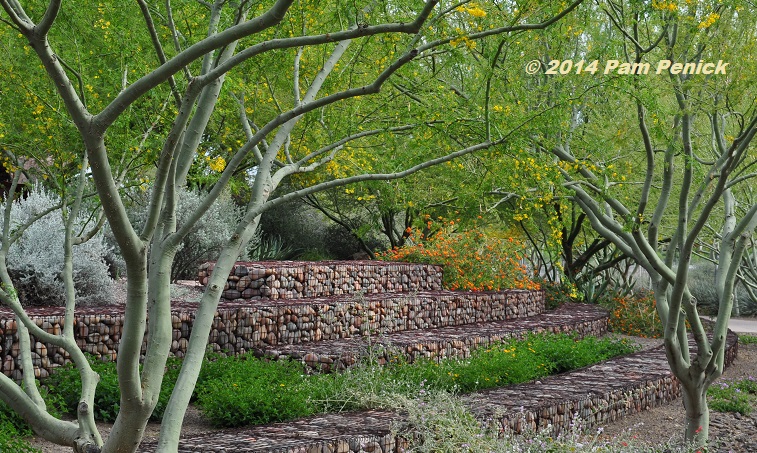
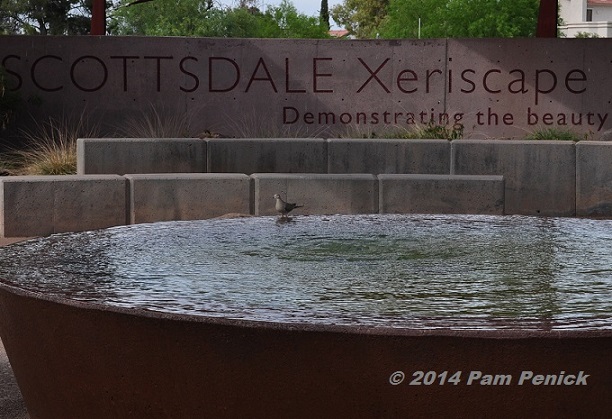
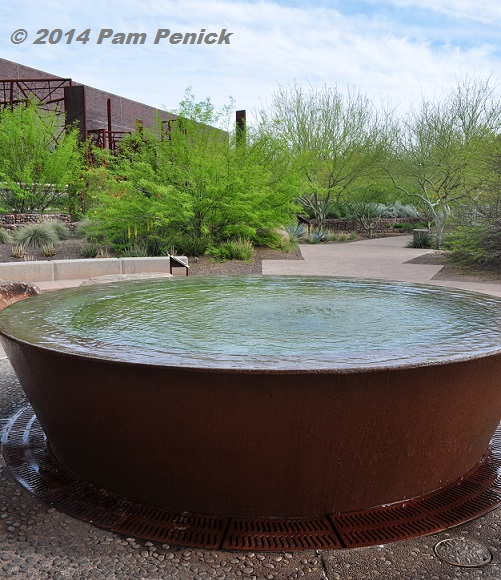
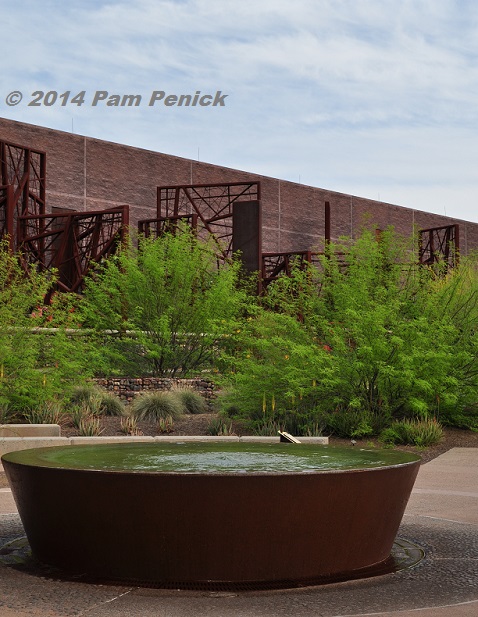
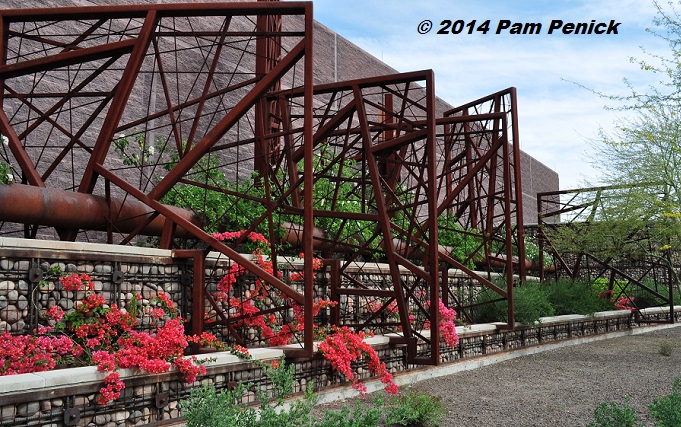
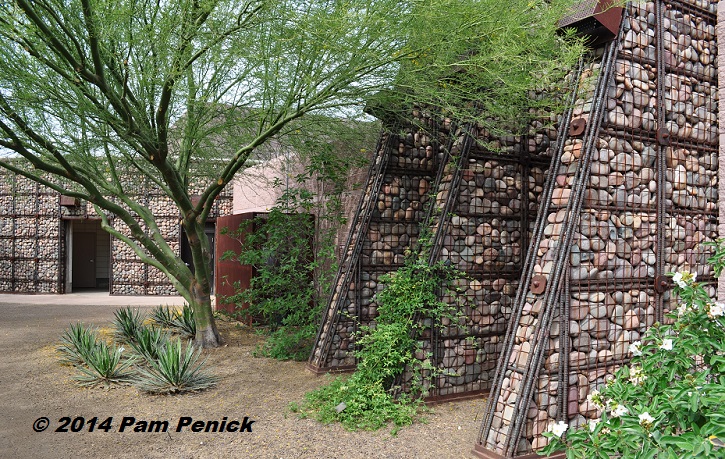
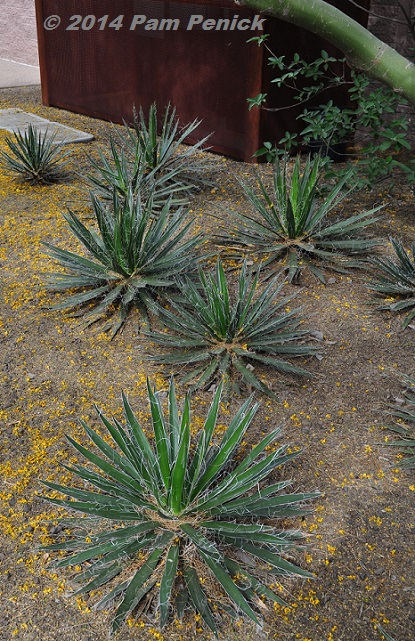
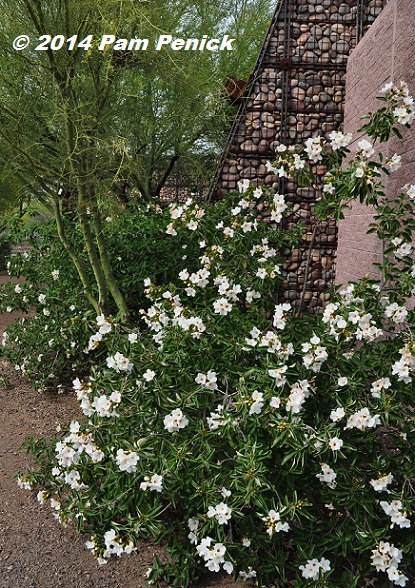
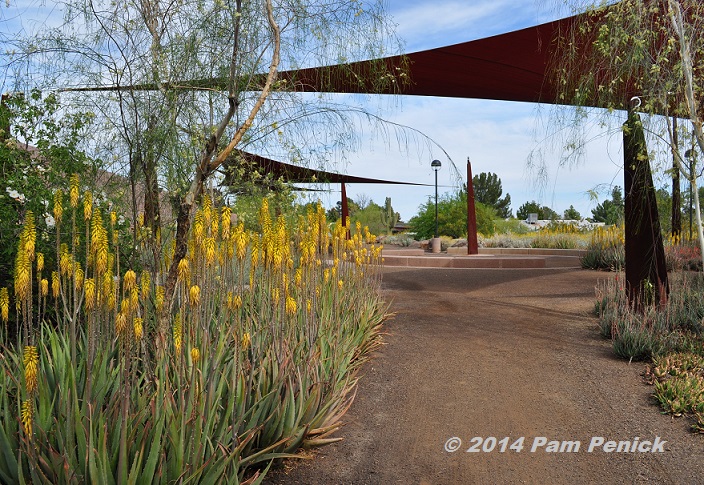
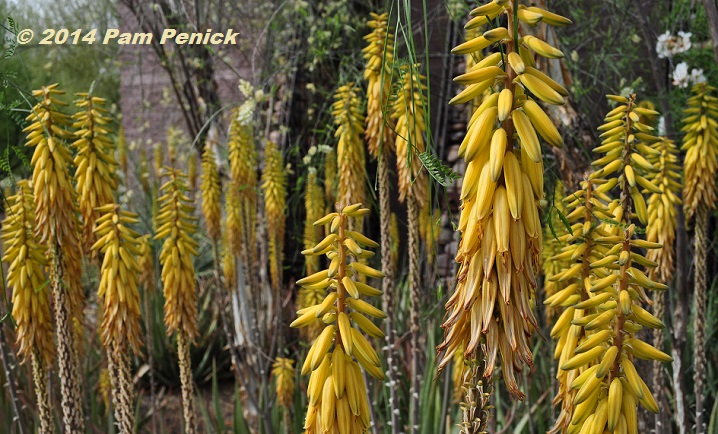
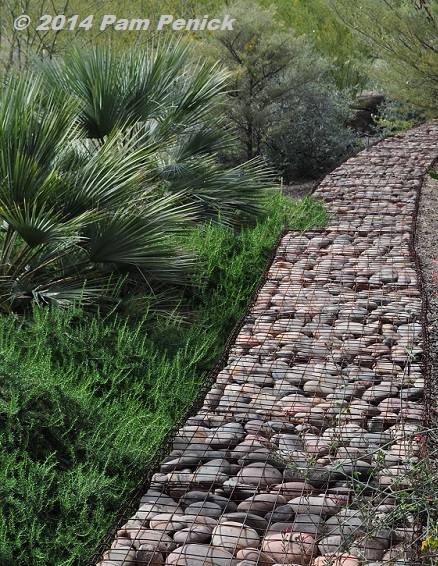
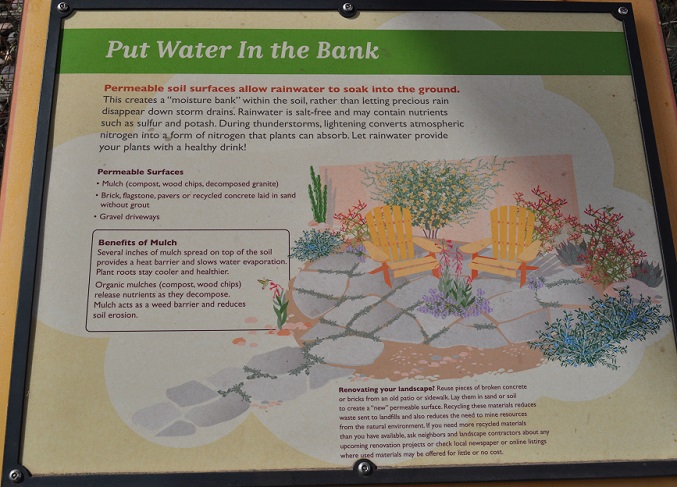
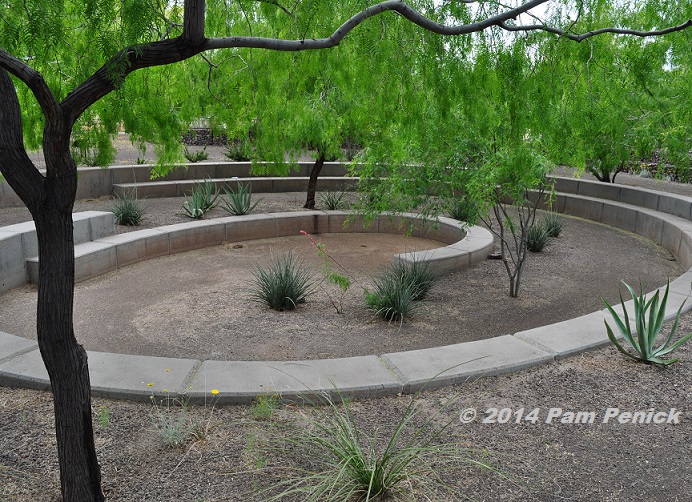
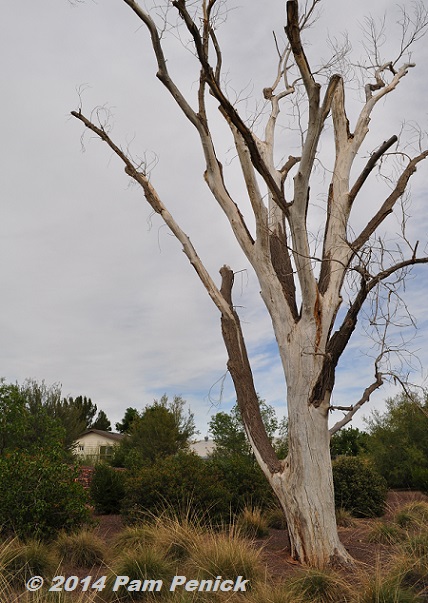
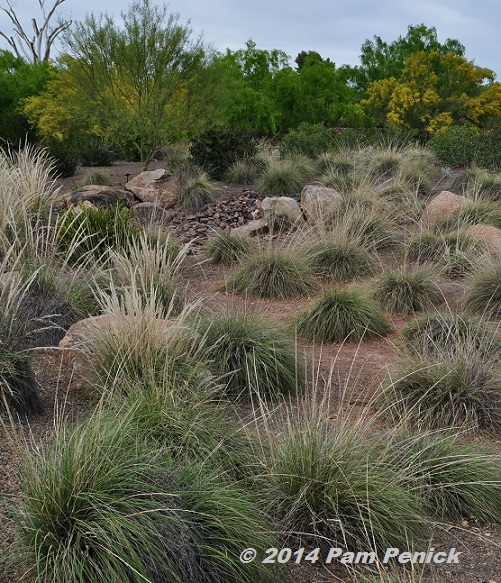
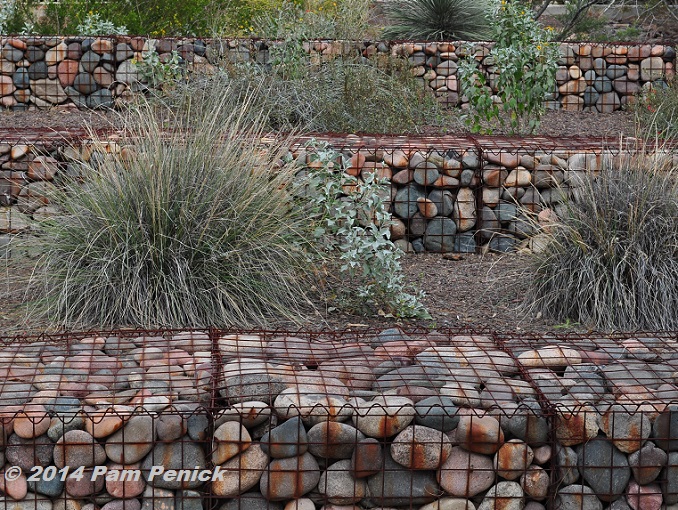
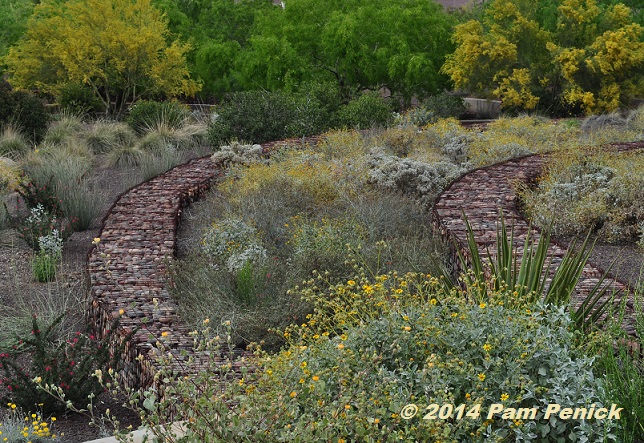
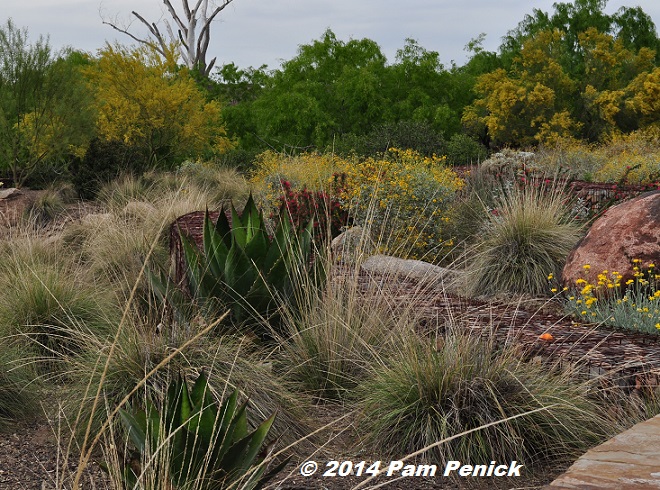
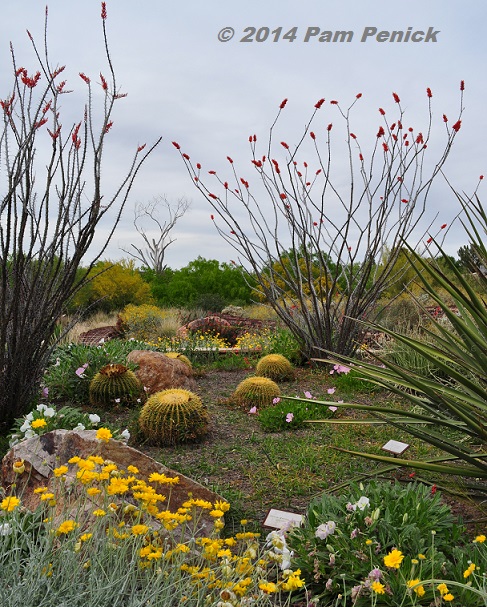
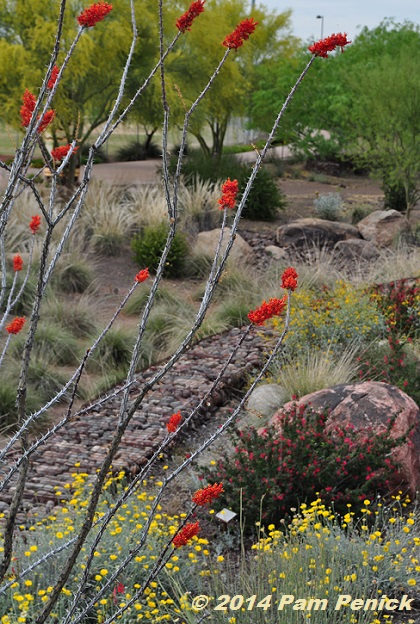
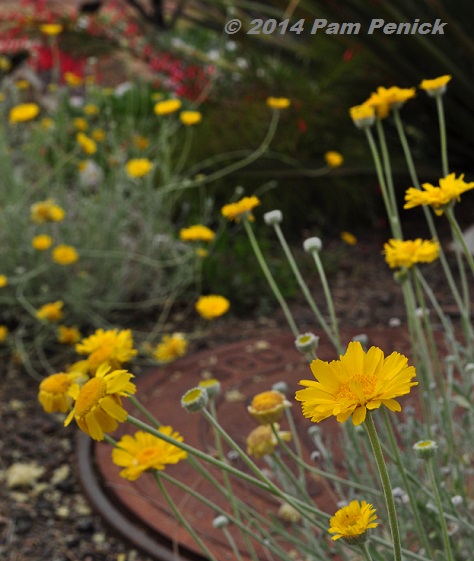
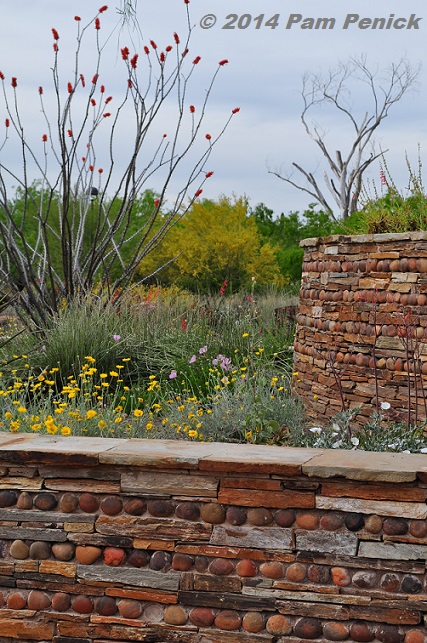
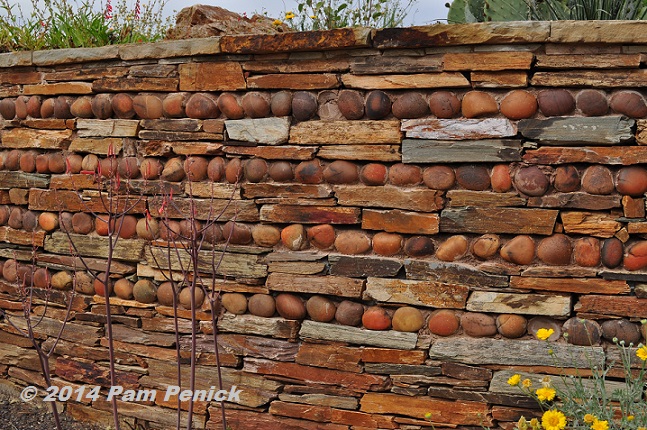
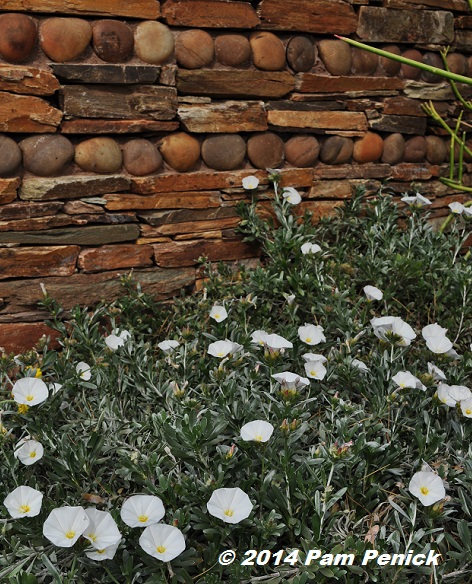
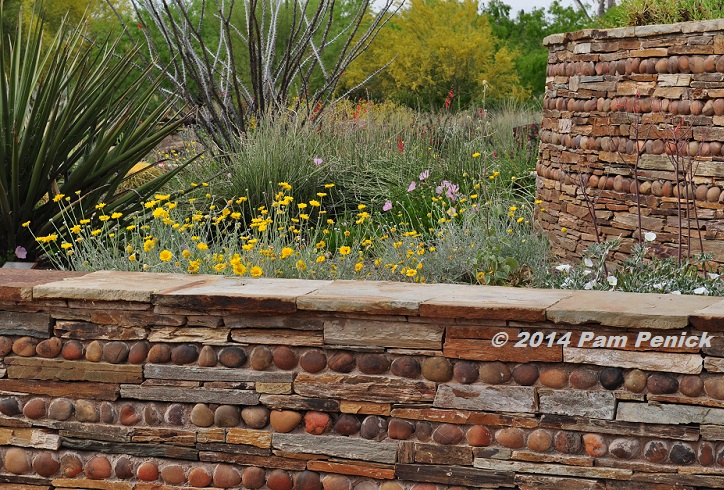
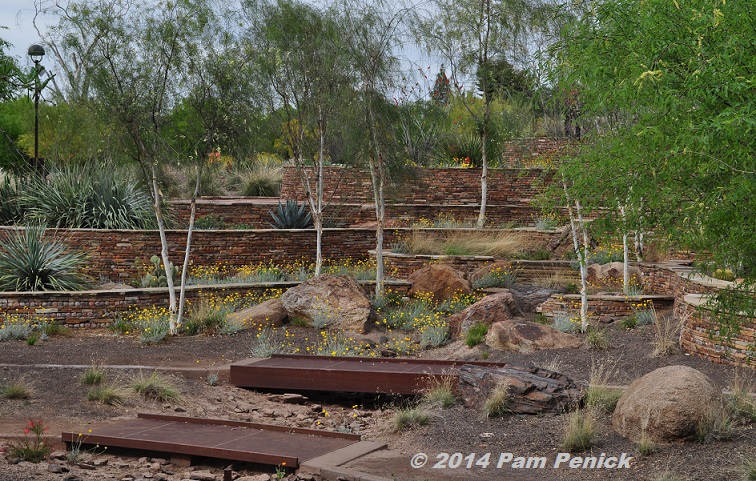
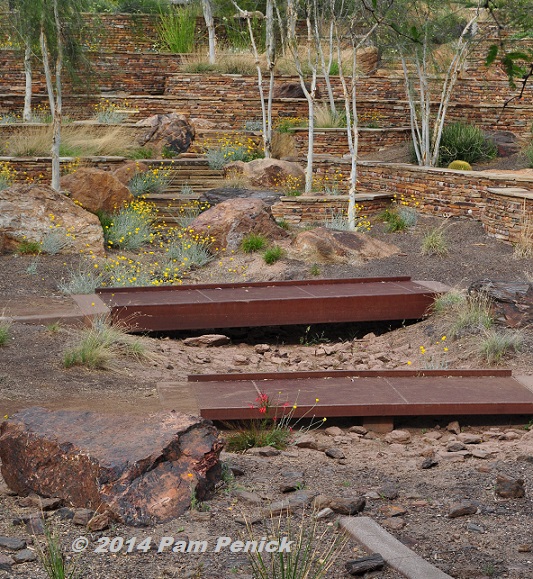
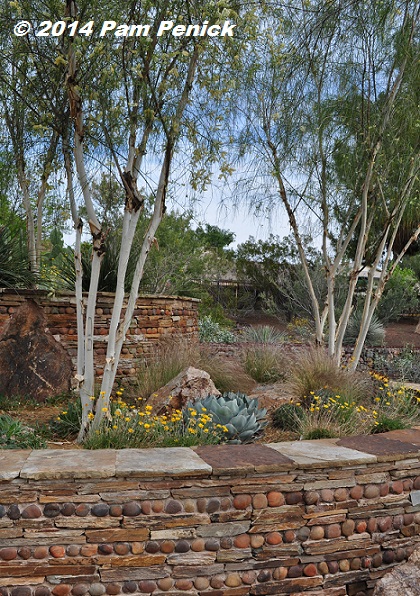
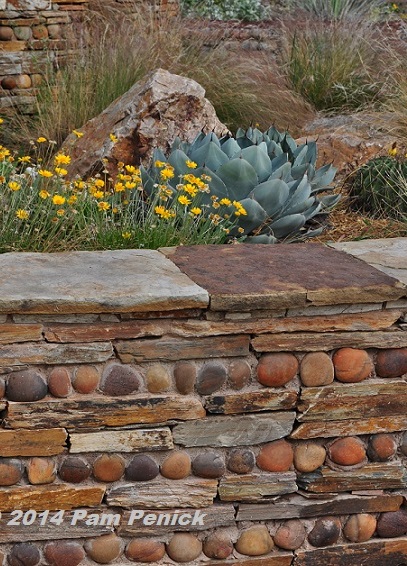
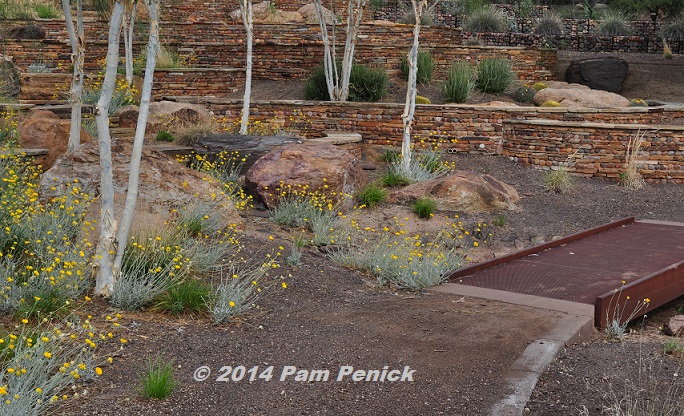
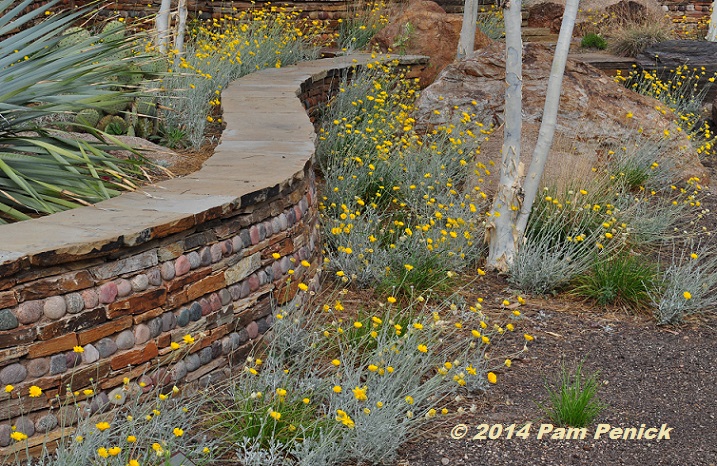
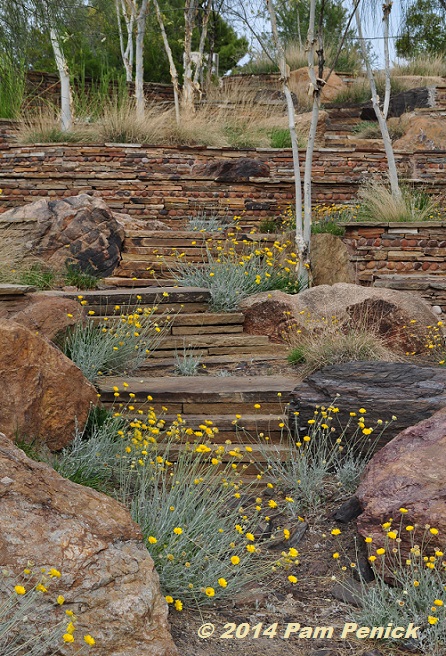
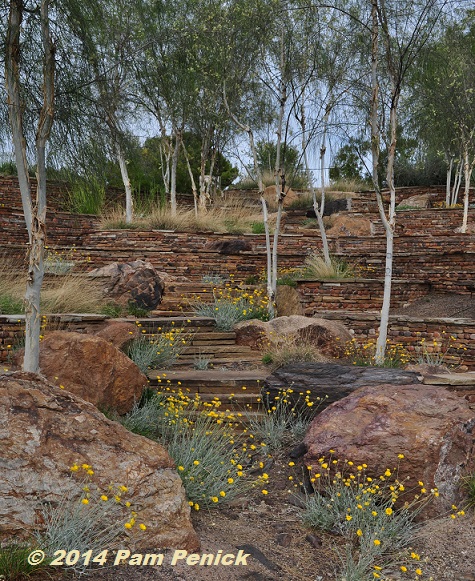
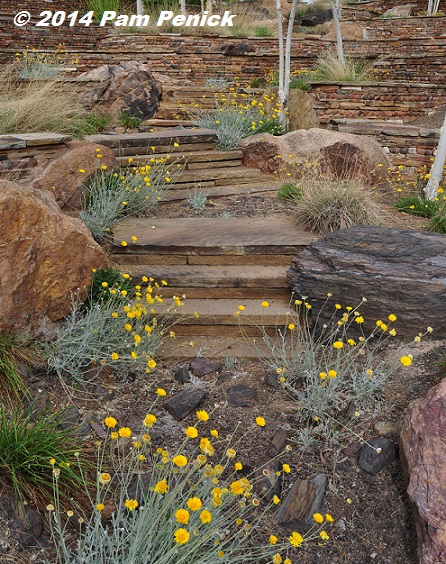
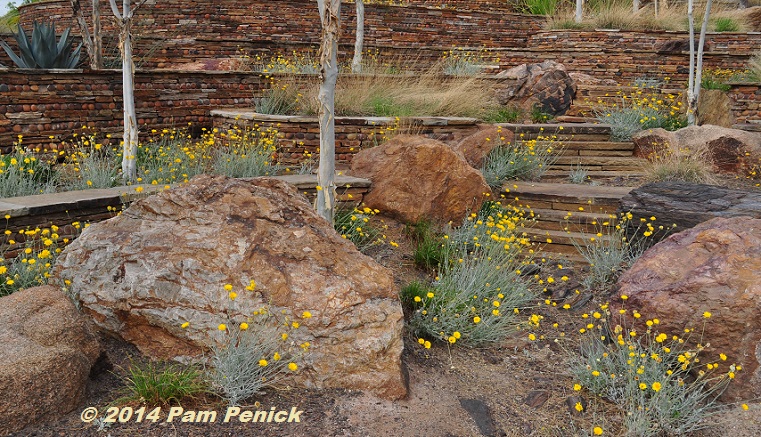
What a fabulous garden, with the most amazing hardscape. I love those stone walls and gabions. Thanks for sharing your photos. This is a garden I would love to see in person.
It was such a treat to discover this garden. Even Noelle was surprised to see what a wonderful space had been created here. She said the property used to contain a putt-putt course. —Pam
Fabulous garden~I love the gabion terrace.
Amazing – thanks for showing it to us!
Loved the tour of this garden. The colors, the rocks, the plants–it all works to make the xeric garden into art.
Just beautiful and inspiring.
Now the anticipation to see what Christy Ten Eyck does with the San Antonio Botanical Gardens and The Wildflower Center projects grows even greater.
San Antonio is very lucky to have a public Ten Eyck project in the works. I look forward to seeing its construction as well. —Pam
Those walls! OMG, I adore those walls. Thanks for posting. I’m a big fan of Ten Eyck, and I don’t think I’ll ever get the chance to see this garden in person.
Ann, Phoenix is just a short plane ride away from Austin, and if you love desert plants (and I suspect you do), it’s really worth a trip in early April. Everything was in bloom, and Desert Botanical Garden is amazing. And then you could see this one too. —Pam
Chaparral park in it’s entirety is a fabulous space.
Wonderful off-leash dog park, this garden, a sport area with ball diamonds, and further down a large park structured around a large pond, lots of trees, a great place to walk or just hang out and watch ducks!
The garden is a hidden jewel in the larger park, tucked away behind the ball fields and dog park. I wonder how many casual passersby even realize it’s there. —Pam
This is fantastic! I love everything about it!
WOW! I am in love. That terraced garden at the end with the acacia, grasses, agave and desert marigold is amazing! It’s so cool to see a demonstration like that. Even up in the green PNW people need to see this sort of thing. And its amazing how small changes can have such a great impact.
I agree, Louis. In any climate we should be conscious of conserving water. You’ll need it when all we drought-starved Texans move up there. 😉 —Pam
Love the frog quote – a good reminder to use what we have – not waste it. The gabions are inspiring too and the color provided by the stone chosen for those walls is certainly appropriate for the surroundings.
I’m completely smitten with the repetitive use of just a few plants as demonstrated in your photos. I have something of the opposite going on in my spaces currently with trial plantings of anything the pollinators like (and deer supposedly don’t) dotted everywhere. I’m waiting to see what naturalizes and takes off given the restrictions in place and whatever dies off, well, so long! I have long range plans to reinforce the impression made by the survivors by adding in more of the same, and this is the precise inspiration I need to be patient and let the beds guide me as to what will work where. Thanks as always for posting!
It’s so hard for home gardeners who love plants to exercise restraint in choosing just a few plants. And to attract diverse wildlife, you really need a lot of different plants. So maybe you don’t need to change a thing, TexasDeb! I agree though — it is a very inspiring look. —Pam
Those are the best gabion walls I’ve ever seen! The whole garden is fabulous. Thanks for sharing your visit!
These gabions were so well suited to the site. —Pam
This garden is beautiful! With plants like palo verde trees, ocotillo, Cordia, aloes, and so many other beautiful plants adapted to arid climates, there’s no excuse for either water-guzzling yards or “zeroscapes”. I especially love the area with the walls and the palo blanco trees. What is it about small, white-barked trees that is so appealing?
Those ghostly trunks must look great in the evening and by moonlight as well. Plus they stand out against the reddish walls. —Pam
this I would love to see. Food for thought, and for the heart.
Exactly right, Diana. —Pam
I’m putting this on my list of must-see’s when I’m next in Phoenix!
You’ll enjoy it, Loree. —Pam